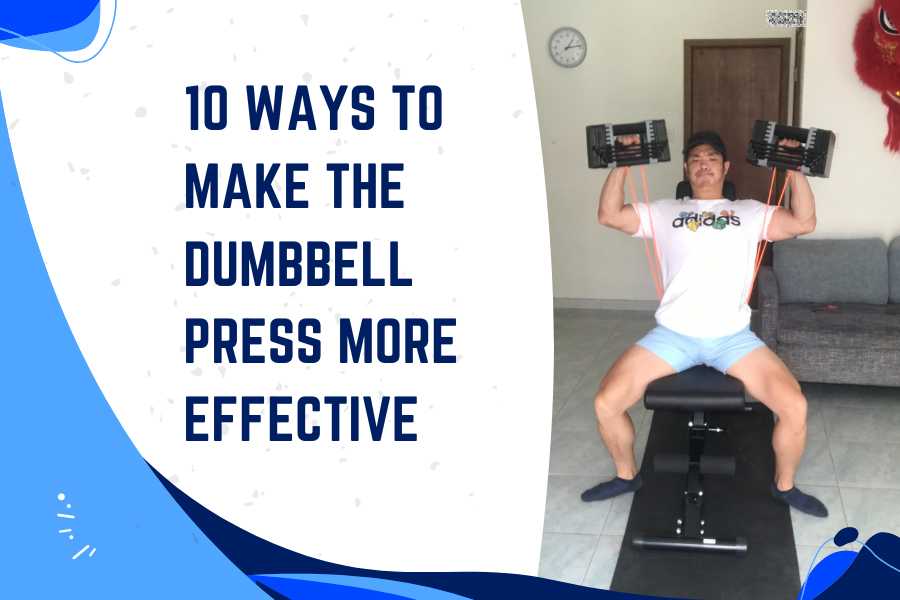To progress with the dumbbell press, it’s important to make it harder over time. The simplest way is to add weight. But this may not always be possible. Below, I reveal 10 simple ways you can use to make the dumbbell press more difficult.
The easiest way to make the dumbbell press harder and more effective is to increase weight. Other alternatives to make the dumbbell press more difficult include doing isolation lifts first, applying pause reps and supersets, increasing reps and range of motion, and decreasing lifting tempo.
My first pair of dumbbells were cheap and had very limited weight. So after my strength had developed, I needed to overcome the problem of increasing dumbbell pressing intensity without the need to add more weight plates.
The tips I share below are based on personal experience and research, and can be applied to both the dumbbell bench and shoulder press!
Let’s get stuck in.
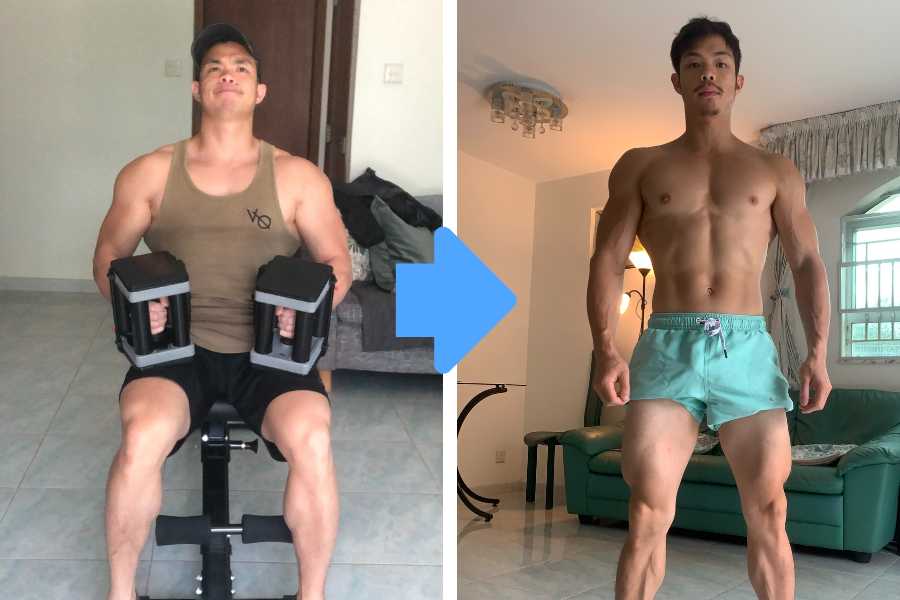
Key Points
- Free methods to increase bench press intensity without extra equipment include; supersetting, tempo reps, lifting more reps, pause reps, and increasing ROM.
- Methods that require extra equipment include; microplates, bands, and buying heavier adjustable dumbbells.
10 Ways To Make The Dumbbell Press Harder & More Effective
The ideal dumbbell weight for promoting muscle growth is anywhere between 50-90% of your 1RM for a given exercise.
But most of us only have a limited amount of weight settings before we max out on our dumbbells. Others may be struggling to increase weight if the next increment is too heavy to lift or if they’re recovering from injury.
Here are 10 ways to make the dumbbell press harder, break through strength plateaus, and keep making gains!
1) Fatigue The Primary Muscle With Isolation Lifts First
Dumbbell pressing exercises can be made harder by first fatiguing the target muscle with isolation-type lifts. After the muscle has been fatigued, it becomes much harder to perform the compound movement of a dumbbell press. This can make the dumbbell press more challenging.
Isolation-type lifts can be easily identified because they move around a single joint and work one muscle at a time.
Here are some examples of dumbbell chest and shoulder isolation exercises:
| Chest Isolation Exercise | Muscle Worked | Shoulder Isolation Exercise | Muscle Worked |
|---|---|---|---|
| Chest fly | Pectorals | Lateral raise | Lateral deltoids |
| Floor fly | Pectorals | Front raise | Anterior deltoids |
| Standing crossover | Upper pectorals | Rear delt fly | Posterior deltoids |
I’d recommend choosing 2 exercises in each muscle group to target 2 different muscles, and then performing 3 or 4 sets for each exercise before moving onto your dumbbell bench/shoulder press.
For example complete 3 sets each of the floor fly or standing crossover before performing 3 sets of the dumbbell bench press. Or complete 3 sets each of the lateral raise and front raise before doing 3 sets of the dumbbell shoulder press.
You’ll find this method smokes the primary target muscle even before they’ve even begun to be worked by the pressing movements. And this can make dumbbell press more difficult and effective.
2) Superset Different Pressing Exercises
Supersets and giant sets can make dumbbell pressing exercises more difficult by increasing the metabolic challenge presented to the muscles on each successive exercise. Each pressing exercise in a superset will fatigue unique muscle groups, making the next pressing exercise harder to perform.

Just to be clear:
A superset involves performing 2 back to back exercises without a break, whilst a giant set requires you to perform 3 exercises.
I’d recommend choosing exercises that follow similar movements but also with different muscle groups.
Here are some examples of recommended super/giant set dumbbell pressing routines:
| Dumbbell Press Exercise | Super/giant Set With: |
|---|---|
| Flat bench press | Incline bench press, close-grip dumbbell chest press |
| Incline bench press | Flat bench press, dumbbell floor chest press, close-grip dumbbell chest press |
| Close-grip dumbbell chest press | Flat bench press, dumbbell floor chest press, incline bench press |
| Dumbbell floor chest press | Incline bench press, close-grip dumbbell chest press |
| Hammer-grip shoulder press | Overhead press, Incline bench press. |
| Overhead press | Hammer-grip shoulder press. |
For example: try supersetting dumbbell floor and incline bench presses by first doing 8 reps of the floor press immediately followed by 8 reps of the incline press (without any rest in between).
You’ll find that supersets are much more difficult than regular sets!
3) Decrease Tempo Of Dumbbell Pressing Reps
Reps can be made harder by increasing time under tension. This can be achieved by prolonging the upward concentric phase of the movement as well as the downward eccentric phase. It’s recommended to aim for a complete rep duration of at least 6 seconds per rep.
This is called time under tension (TUT) training and it’s a simple way to increase the effectiveness of each rep of a dumbbell press.
Studies have found that that 3 types of stimuli are responsible for muscle development:
- Mechanical tension- total amount of weight lifted in a set.
- Metabolic stress- total amount of metabolite accumulation (e.g. lactate) in response to low energy conditions.
- Time under tension- total time your muscle is contracted in a set.
Therefore prolonging each rep is a great way to make your dumbbell press harder and more effective when you don’t have access to heavier weights.
I like to do a 2 second concentric and 4 seconds eccentric to get a really good pump.
Additionally, studies have shown that TUT training is effective for stimulating the type I slow-twitch fibers which are hard to activate during conventional weight lifting reps. These fibers contribute to muscular development.
“Protein synthesis is particularly sensitive to extended time under tension”
Schoenfeld et Al. 2014.
You’ll also find that TUT training is great for improving your dumbbell press form because you’re forced to lift slowly and controlled. And this will make your training more effective.
4) Increase Reps Within The Hypertrophy Range
It is recommended to perform 6 to 15 reps per set of dumbbell presses for muscle growth. To achieve maximum hypertrophy, it is also essential to use a weight that is between 50-85% of the person’s 1 rep max. The exact weight will vary depending on the chosen rep number.
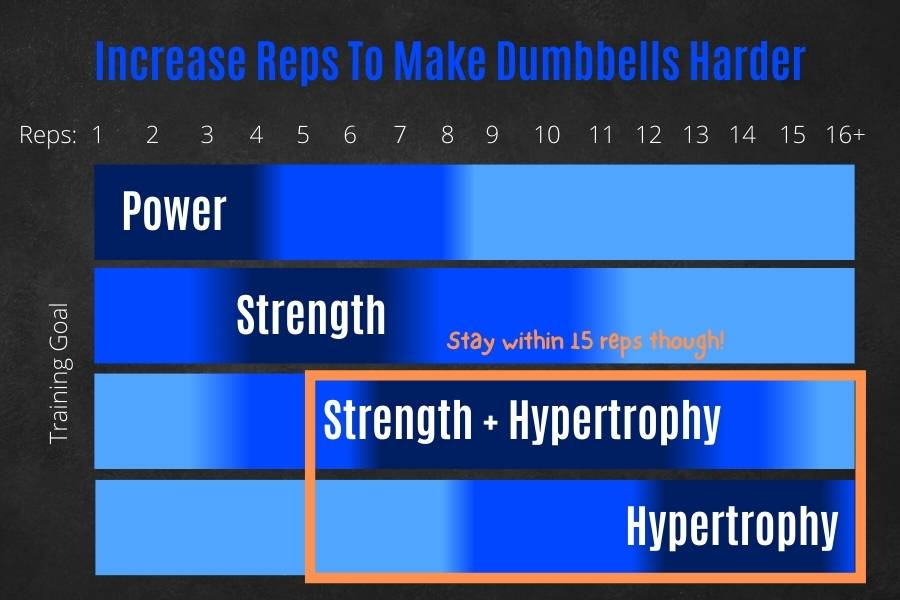
The higher the rep range the lower the weight should be.
With this in mind, if you’re currently working in a low rep range (i.e. <8 reps per set), you can increase the reps to anywhere within the 15 rep limit.
This will make the dumbbell press more difficult and drive greater training results without having to add more weight.
Just make sure you don’t exceed 15 reps if you’re primary goal is to build a bigger chest with your dumbbells because you’ll begin training for muscular endurance rather than hypertrophy (growth) at these rep ranges.
Once you reach a stage where you can comfortably do 15+ repetitions, you should begin finding other ways to increase dumbbell press intensity without having to add more reps.
5) Take Advantage Of Pause Reps
Pause reps are an effective way to increase dumbbell press intensity. This can be achieved by introducing a 1 to 3 second pause halfway through the upward concentric phase and/or the downward eccentric phase. A pause can also be added at the end of the eccentric phase.
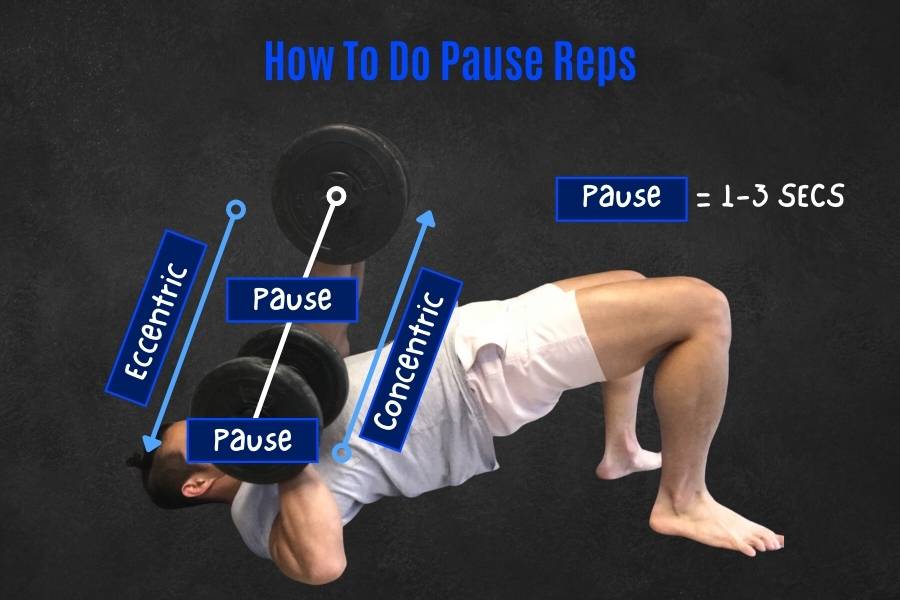
Regardless of your chosen style of pause reps, the idea is to make the dumbbell press more challenging.
When you add a pause/s to your reps, you reduce the effect of residual plyometric (elastic) energy in the muscle.
Therefore pause reps force your muscles to use 100% pressing strength to lift the dumbbells back up without elastic assistance.
As a result, the dumbbell press becomes more difficult and presents a greater growth stimulus to the muscle.
But be aware that the amount of weight you can press with your dumbbells may be reduced by 5-10%. However, the lift will likely feel much harder to perform.
Additionally, pause reps add complexity to your dumbbell press. And this can make your training more enjoyable.
“Pause reps can make your workouts more interesting, which encourages you to work harder in them.”
Mike Matthews, Legion Athletics.
If you’re unsure about how much weight you should be dumbbell pressing, you’re free to check out my other articles for:
- Flat and incline dumbbell press weight standards
- Shoulder press weight standards.
- Barbell vs dumbbell press weight comparison.
Both articles also detail how you can improve your bench/shoulder press, respectively.
6) Increase Range Of Pressing Motion
Increasing the range of motion can make the dumbbell press harder and more effective. Dumbbells should touch the chest at the bottom of the bench press and touch the shoulders at the bottom of the overhead press. Additionally, the arms should be extended at the top of both presses.
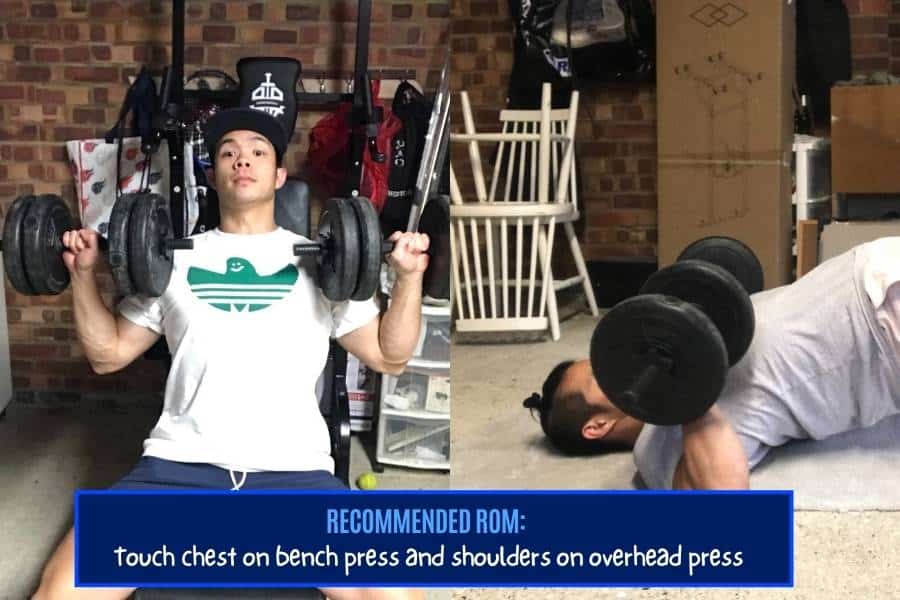
Studies have shown that a greater range of motion (ROM) is important for maximizing the benefits of weight training because it leads to greater muscle activation. And speaking from experience, not training with a full ROM is a common reasons why your chest isn’t growing slowly.
And greater muscle activation correlates with greater strength increases.
Therefore allowing your dumbbells to drop lower than your current ROM can be a simple way to increase dumbbell press difficulty and make it more effective.
Be careful with this method though- allowing the dumbbells to drop too far down can be painful if you’re not used to the motion.
Likewise- whilst the arms should be extended at the top of the movement, the elbows should not be locked.
My advice is to experiment by slowly increasing the ROM of your dumbbell press over the course of a few weeks, and never exceed a point where it becomes painful.
7) Microload To Increase Existing Dumbbell Weight
Micro loading can be a practical way to increase existing dumbbell weight. This involves the use of accessory weights to increase the resistance of the current dumbbell by 1-10 pounds each. Examples of microlending accessories include magnetic fraction plates and wrist weights.
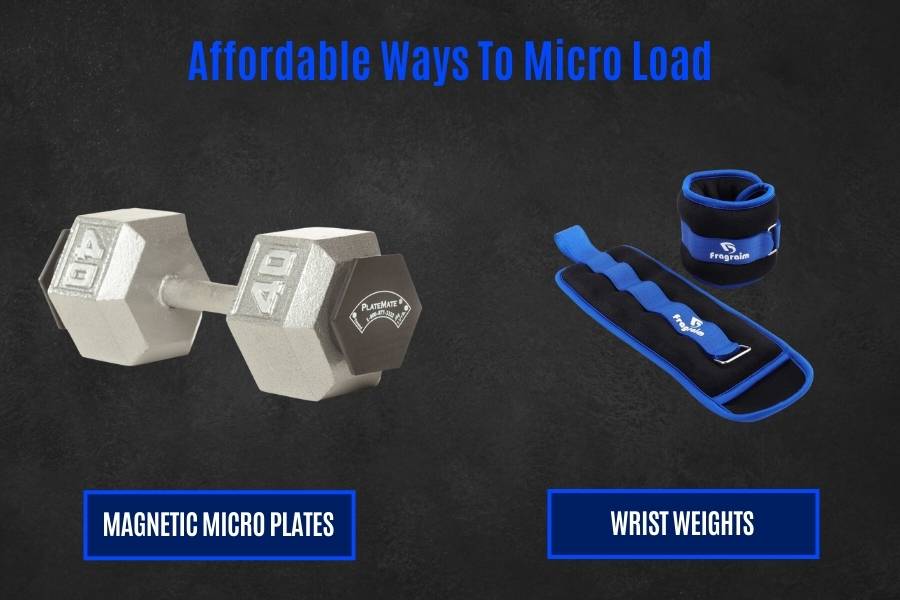
Microloading is a great way to increase current dumbbell weight at home if they’ve already been maxed out.
Platemate is a reputable brand that makes microplates at:
- 0.25lb per plate.
- 0.50lb per plate.
- 1.25lb per plate.
- 2.5lb per plate.
They work best on uncoated iron but are also compatible with some urethane-coated dumbbells (type your dumbbell model into the “questions” search tool on the Amazon product page to find out).
For heavier loading, you can use wrist weights like the Fragraims which go from 0.5lbs to 7.5lbs per weight.
These can be strapped onto your wrists with heavy-duty velcro and make your dumbbell press more difficult and effective.
You can check out my other post for more details on how to increase dumbbell weight and build more strength.
9) Overload Dumbbell Press With Resistance Bands
Resistance bands are an ideal way to add heavy resistance to existing dumbbells. These can be wrapped around dumbbell handles and an anchor point to make dumbbell exercises harder to perform. Bands with different resistance levels can be used to adjust dumbbell weight to different degrees.
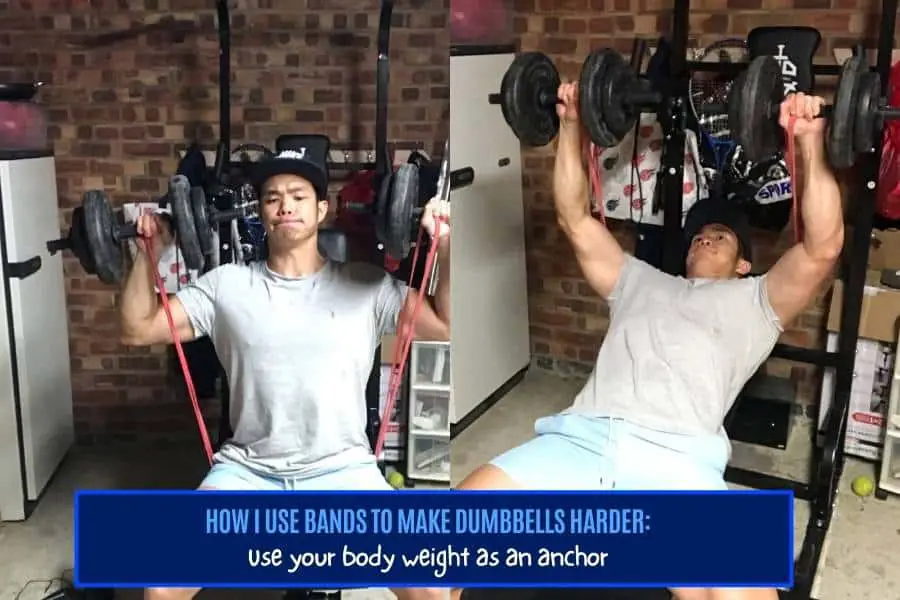
This is one of my favorite ways to increase maxed-out dumbbell weight at home.
It’s easy, cheap, and highly effective (you’d be surprised how much resistance a bunch of bands can create).
From squats to bench presses to shoulder presses, this method can be applied to just about any dumbbell exercise.
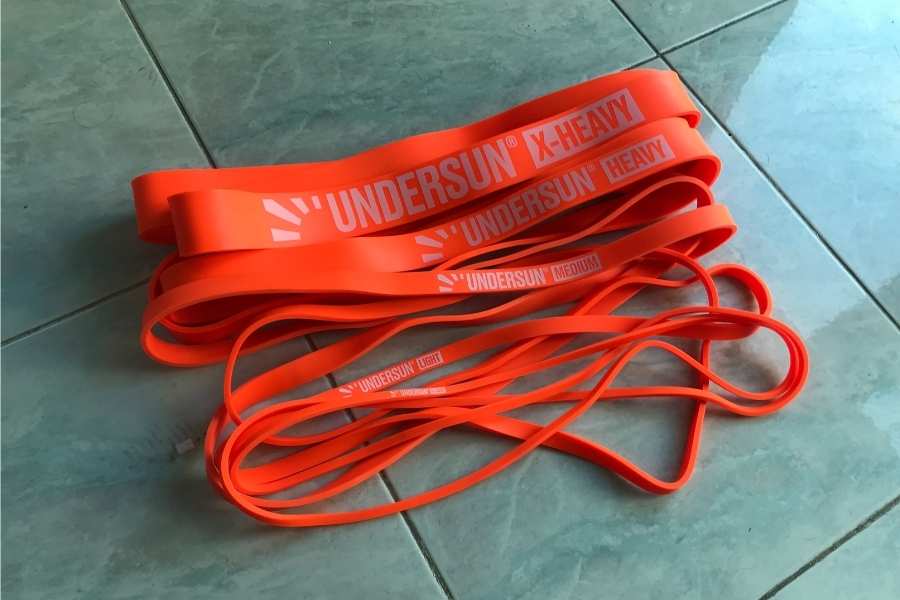
I use and recommend the Undersun bands. You can find out why in my review here.
Unlike the cheaper models (two of which have snapped on me in the past), the Undersuns are extremely durable and come with a lifetime warranty. They aren’t that much more expensive either.
They can also be used for standalone band exercises (check out James Grage’s Youtube channel).
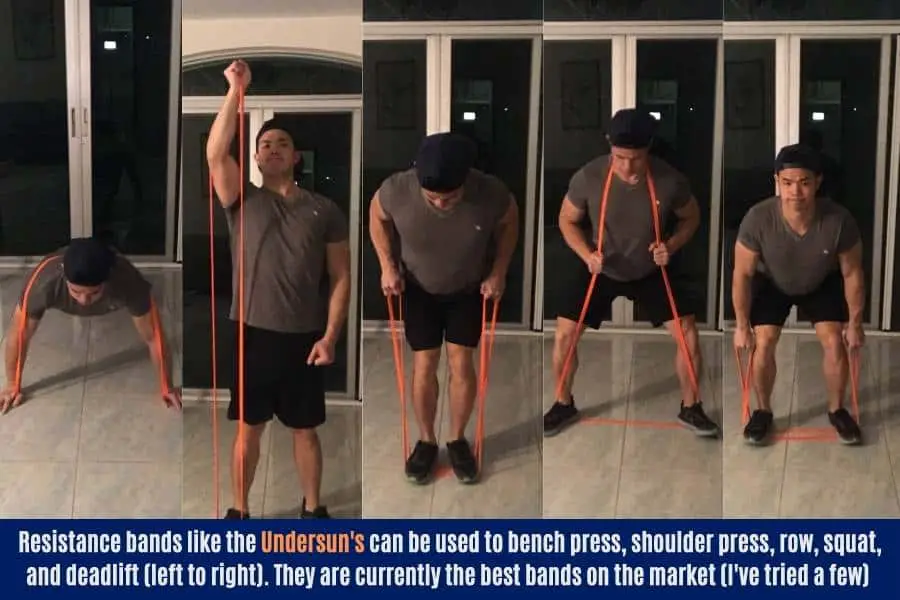
If you decide to use them for this purpose, I’d highly recommend getting some cheap gloves like the Ihuans to protect your hands from friction burns.
You can check out my other post to learn how resistance bands work and why they are so good!
10) Upgrade To Heavier Dumbbells
The last and easiest way to make your dumbbell pressing more demanding- upgrade to heavier dumbbells of course!
I put this last as it’s the most obvious method.
But hear me out.
If you’re currently using cheap light dumbbells, it may be time to consider upgrading them (since you’re so far into this post anyway)
This is especially true if you’re serious about dumbbell training and confident that they’re the best way for you to reach your long-term training goals.
I now use and recommend the Powerblock Elite EXPs. They will last you a long time unlike cheap spinlocks (shown in the photos above).
You can go to my other post here to find out my favorite dumbbells for chest workouts.
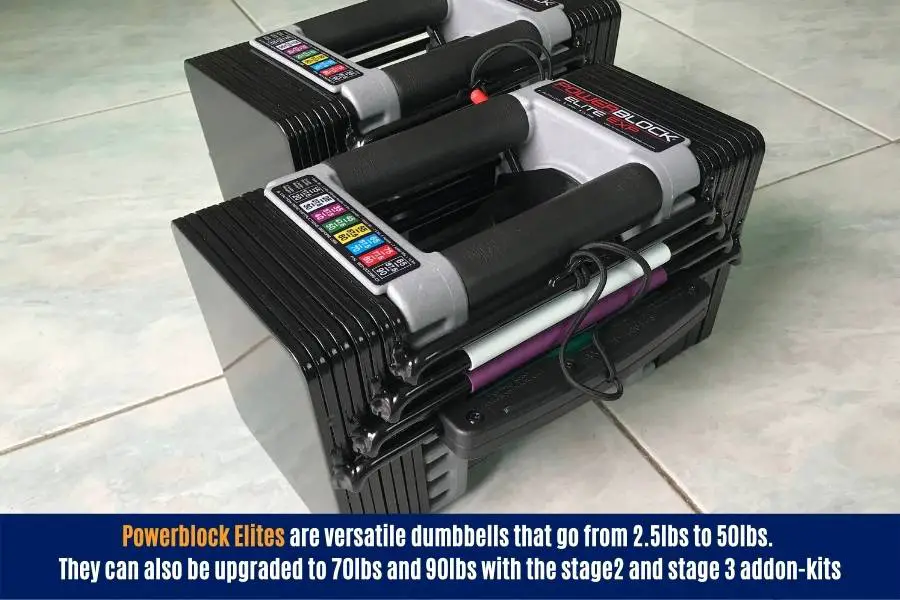
The base unit weighs 50lbs per dumbbell which is great for beginners to start pressing with. But they can also be upgraded to 70lbs and 90lbs whenever you become strong enough.
This means you don’t need to fork out hundreds of bucks from the get-go.
But you still have the flexibility to upgrade whenever the time comes.
They also come with small 2.5 and 5lb increments. These are great for progressive overloading and performing the isolation lifts mentioned at the start of the article.
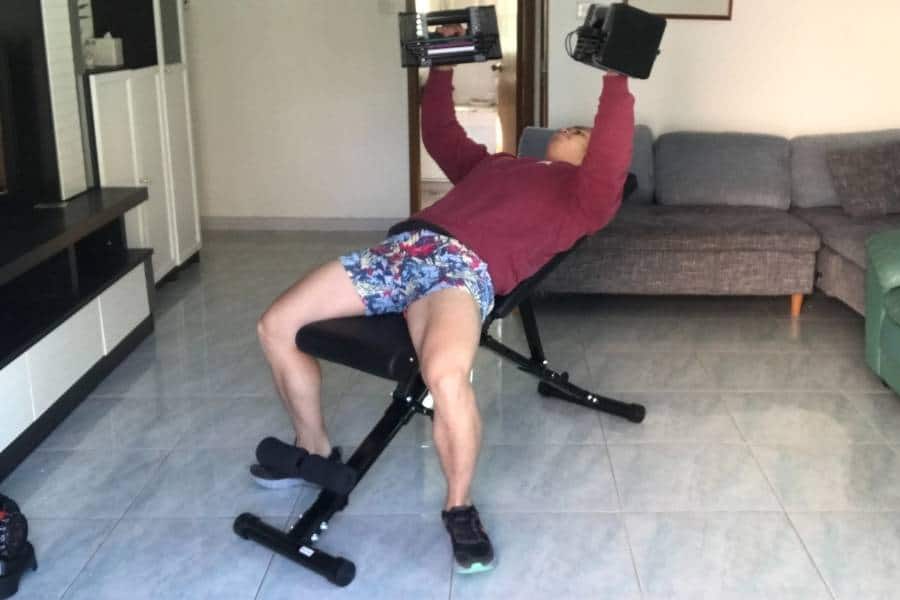
If you’re currently training with barbells, then it may still be worth investing in dumbbells.
Studies like this one have found that dumbbell bench pressing is harder than barbell pressing, and also leads to a greater degree of pectoral activation.
Conclusion
I’ve shared 10 ways to make the dumbbell press harder and more effective.
Some of these tips involve using creative ways to increase exercise intensity without changing the dumbbell weight. Whilst other tips allow you to increase the weight on your existing dumbbells that have already been maxed out.
I would advise applying a combination of methods for the best results.
You may also be interested in the downloadable Kalibre Blueprint PDF which details exactly how I gained 40lbs of lean muscle (it’s 100% free!). It details the exact exercises and nutrition (with printables) I used to go from skinny to ripped!

